
You want to SEO website, SEO keywords to the top but do not know what SEO is? This article will guide you about seo in detail: onpage seo, offpage seo, keyword research, etc. so you can get a basic idea of SEO.
“Search engine optimization” (SEO) refers to techniques that help your website achieve better rankings in the organic search results. “Search engine optimization” is the job of making your website more visible to people who are using search engines to search for your product, brand, or service.
SEO is a part of Search Engine Marketing ( SEM ), a group of marketing strategies related to the search process.
Part 1: Introduction to SEO

#first. What is SEO?
“Search engine optimization” (SEO) refers to techniques that help your website achieve better rankings in the organic search results. “Search engine optimization” is the job of making your website more visible to people who are using search engines to search for your product, brand, or service.
SEO is a part of Search Engine Marketing (SEM), a group of marketing strategies related to the search process.
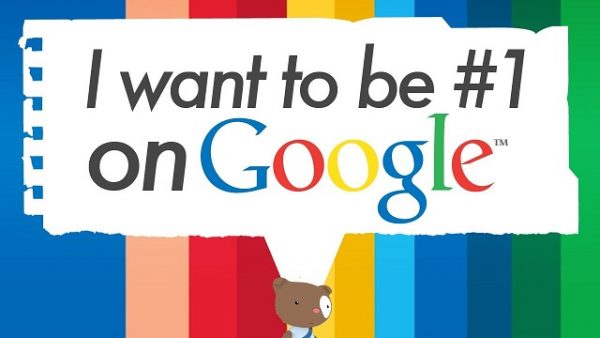
SEM is part of Online Marketing and includes both paid and organic searches. All methods involving you paying to place ads in search engines are grouped together under SEA- Search Engine Advertising. So SEM includes both SEA and SEO.
SEA methods involve you paying to have your website listed in the visible area of a search engine when entering specific queries or search terms. Organic and paid listings both appear on the search results page. However, they appear in different places on the results page. Paid text ads are also marked as such.
Why is it important for your website to be displayed on search engines?
Every year more than 2.8 trillion search queries are made on Google alone. This means that Google answers more than 88,700 searches worldwide every second. In other words: Every second that your site is not indexed on Google, you miss out on hundreds, if not thousands, of opportunities where someone could visit your site, view content, and purchase products or services. your service.
By optimizing your website for search engines, you can not only improve your ranking to be found by potential customers, but you can also create a better user experience. That’s the key to SEO: you’re optimizing for visitors, not just for search engines.

Doing good SEO takes time
Successful search engine optimization does not include short-term actions to achieve quick rankings. Instead, SEO is an ongoing process that requires you to continuously optimize your website.
These changes are important because search engines are always upgrading and changing their criteria for good rankings. So, as a webmaster, you should always aim to provide users and search engines with the best possible results for each relevant search query.
You will satisfy the needs of your users by providing unique content and a website that works well on any device.
SEO methods will help you achieve this goal. To achieve and maintain good positions on the results pages (SERPs) over the long term, you should follow search engine guidelines and focus on your target visitors (how to proceed). This approach is called “white hat SEO”). Google and other search engines are very quick to identify unauthorized, manipulative techniques and your site may be penalized.
Such a penalty can cause your site to drop in the rankings.
#2. How search engines work
Search engines have one purpose: to provide searchers with the exact information they are looking for.
For a search engine to be able to display relevant results when a user makes a search query, there must be an archive of information available to choose from. This repository is called an index. Each search engine has its own method for crawling and categorizing content from web pages. Regardless of the specific tactics or methods used, the process is known as indexing. Indeed, search engines attempt to scan and index the entire online universe. By doing so they can show you relevant information when you search for it.
How does this work? Every search engine has a program called a “bot” or “crawler”. These programs follow the link and visit the site. When they do, they index the site content and follow the links on the site to other sites. If your site has not been indexed, it will not appear in the search results.

Major search engines like Google, Bing and Yahoo continuously index billions of web pages. But how do they know what they have to show you in the SERPs when you initiate a search query?
There are two important things that help search engines categorize websites:
1. The content of the website: When they are indexing the web pages, the “bots” of the search engines will scan all the URLs of the website and look for the starting points of the topics. protected. They also browse the HTML code for metadata such as specific tags or attribution marks, so that they can determine the relevance of each page for specific topics.
2. Links to Websites: While search engine bots are scanning web pages for indexing purposes, they also look for links to other websites. The higher the quality inbound links, the greater its link authority. In theory, each inbound link counts as a positive recommendation for a website. However, it is not the quantity but the quality of inbound links that plays the biggest role for search engines. For example, search engines may value a link from a trusted site, like the New York Times (nytimes.com), more valuable than a link from a small, unrelated blog site. Boosting from inbound links is also referred to as “links juice.”
When a search query is typed, the search engine looks in its index, even as it is being entered, for the most relevant information and displays the results in the SERPs. The results are then sorted by relevance.
When you run the same query on different search engines, you may get different results. This is because each search engine uses its own algorithm based on a variety of ranking factors. These factors determine the results that appear in the SERPs.

Google uses more than 900 different factors to determine the relevance of a web page to a search query. Here are some important factors that search engine algorithms take into account when ranking a website:
+ Website content
+ Website structure and internal linking
+ Searcher geolocation
+ Mobile optimization
+ Load time
+ Server accessibility
+ Signals social (links from social networks)
With a market capitalization of $470 billion, Alphabet Inc dominates the search engine market with Google’s search engine.
Google is the market leader because the company is fundamentally revolutionizing the way the search engine works. The search engine group has a market share of over 93% in Germany, and has held this position continuously for many years. In the United States, Google has a market share of just under 64%, followed by Bing with over 21%.
In the pre-Google days (circa 1997), search engines only indexed web pages and took into account factors such as keyword density and keyword meta tags when determining site relevancy. related to search queries. This approach is known as “black hat SEO”.
It involves, for example, tactics such as “keyword stuffing”, whereby web pages have been deliberately crafted with as many keywords as possible in order to achieve high rankings in the results. search results.
#3. How to rank on search results pages / Things you must do for good SEO
It is not difficult to guarantee that your website will be indexed by a search engine. However, it can be tricky to make sure it’s listed with specific keywords. Search engines rely on four things to determine rankings: rankings, authority, relevance, and technical issues.

Places
Ranking is the position your website occupies in the SERPs for specific searches. Your rank is an indicator of how relevant a website is to a search term from a search engine’s point of view and what authority it has.
You should regularly check your site’s ranking and position in the SERPs to gauge whether your SEO measures are working. But since there are also many factors that you can’t get, you shouldn’t stress too much about rankings. It is completely normal if your site sometimes jumps from 1-5 points. But if you manage to get your website 10, 20 or 30 points higher, you should be proud of yourself.
Authorization
As described in the “How search engines work” section, search engines determine the authority and reliability of a web page’s content, using factors such as the category and quality of links. inbound links from other sites. However, a large number of inbound links does not necessarily lead to a high ranking. Therefore, search engines also check the authority of the sites linking to you, the context of the link, and “anchor text” (text that contains links to your web pages or another web page). other than your site, these pieces of text will usually be a different color than the text that doesn’t contain the link and is purple or blue) being used. Another important factor in authority is the age of your domain name. Older sites usually have a higher trust factor.
Relation
Relevance is one of the most important ranking factors. Search engines not only detect that you are using certain keywords, but also look for clues about how relevant your content is to a particular search query. In addition to the actual text on your web pages, search engines also check their structure, keyword usage in your URLs, page formatting (such as using bold fonts), and keywords. which appear in the title and in the body of the text.

The work done by search engines is very complicated because, in the end, they try to think like humans.
Google is now very advanced and answers about 15 percent of its search queries with the help of technological intelligence (AI). This AI is called “Rankbrain” and includes machine learning algorithms. The fact that search engines are getting smarter has very practical results for SEO.
For this reason, it may seem tempting to keep changing your site’s content to get better search engine rankings. In the end, however, you’ll do better to put more energy into creating relevant, coherent content aimed at your target customers (and potential customers). The better the search engines become, the better quality and more unique your content should be.
#4. The concept of “long-tail” and theory
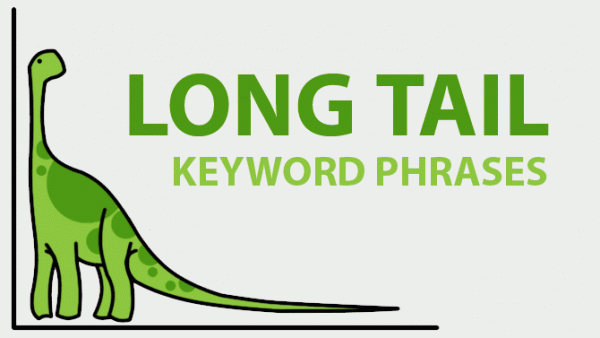
To rank high in the SERPs with your site’s content, you should choose the path of least resistance.
While it seems logical, at first, to strive for rankings using high-traffic keywords and terms, this will lead to a lot of frustration and waste of resources. Furthermore, the traffic that you will get from a highly competitive keyword, will probably be of poor quality.
Unique search queries are better than general searches. If you add in the search engine traffic of the most popular keywords, the metric won’t even come close to the number of unique, distinct keywords. This concept is known as “long tail theory”.
Choosing the right keywords is not always easy. For example, if you sell shoes, you’ll probably want your site to rank for the term “shoe store” (a keyword). However, if you optimize a few pages of your site for a particular pair of shoes, you will have greater success ranking for the appropriate keyword.
A good example is “red tennis shoes with zipper” (long tail keyword). Of course, the number of people searching for long-tail keywords will be less than those searching for “shoe store.” However, you can be sure that that number of people will reach the later stages of the sales funnel and are more willing to buy your product than those searching for the term “shoe store”.
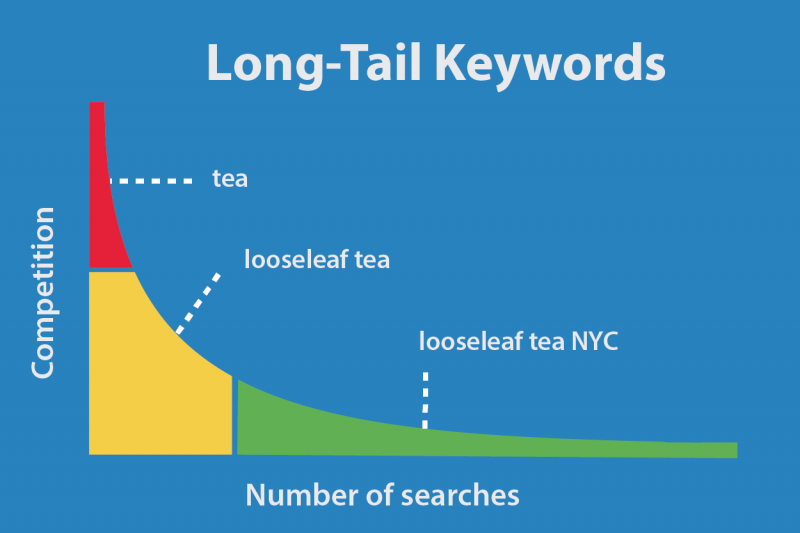
That’s why long tail keywords are so effective. They are aimed at people who want to do something or are looking for specific information, such as a manual or a service that can solve their problem. If you optimize for long tail keywords, you will reap the benefits. You will find it easy to achieve good search engine rankings, get quality traffic, and convert that traffic into leads.
#5. Content is King
Everyone is familiar with the phrase “content is king.” Without rich content, you will not achieve good rankings for specific keywords and drive traffic to your website.

If your content doesn’t provide users with any added value or to entice them, it won’t help in acquiring leads and/or customers. It is unpredictable how people will search for content and what keywords they will use to do so. Therefore, it is advisable to create content that can fully meet the needs of users. It’s not just about quantity (large amount of text); it has more to do with the content’s relevance to potential searches.
For example, think about potential questions about your problems and work with your content to answer those questions as fully as necessary and as succinctly as possible. Create unique content that appears somewhere online. This way, you can improve the likelihood that your site will achieve higher rankings.
As you know, search engines are very smart. So if you create multiple websites on the same topic, you are wasting your time.
Instead, you should focus on one website. When it comes to creating content, there are various ways you can expand your online presence and improve your chances of ranking without repeating the process:
Home: Use your website to communicate your value proposition and general marketing message (known as “premium messaging”). If there’s one page that should be optimized for generic keywords, it’s your homepage.
Product/service pages: If you are selling products/services, create a separate page for each service or product.
Knowledge Pages: Give your users access to a page where they add value and provide more information about your topics. On this page, you can provide graphics, e-books, and white papers.
Blog: Blogging is a great way to stay up to date even when it comes to creating fresh and relevant content easily. Blogging regularly (ideally once a week at a minimum) can have important implications for search engine optimization, as each new blog entry represents a new web page. Practical tips: What makes good content?
1. Give your users genuine added value. Try providing content that no other site offers on the same topic.
2. Make sure you don’t optimize your text by simply adding keywords to your text as much as possible. Instead, try to base content on the term frequency of the top 10 sites in the SERPs.
3. Remember that your content should be “comprehensive”. This means it covers the full theme and covers different formats like graphics, photos or videos.
4. When you create text, remember that web users want to get information fast. So express yourself in as much detail as possible, but as succinctly as possible. For example, avoid long, nested phrases and break up your texts with short paragraphs, bullet points, headlines, and images.
5. Structure your text. This will allow your users to better consume the content.
#6. How to Develop an SEO Strategy
If you are looking for an SEO strategy, you should split it into two parts: Onpage SEO and Offpage SEO. On-page SEO refers to all the measures you can take on your own website. These measures make it easier for search engines to find your site, index it, and understand and categorize your content. Offpage SEO covers matters outside of your website and ensures a flow of high quality inbound links. Let’s start with on-page SEO first.
Part 2: Onpage SEO

#first. What is Onpage SEO?
On-page SEO – on-page optimization is part of search engine optimization and, as the name suggests, it includes all measures and adjustments made on your own website . There are several elements on your website that you can use and allow search engines to index your content and understand what it is about.
#2. Indexability
If your site can achieve rankings in the SERPs, it must be indexed.
You can affect the indexability of your site, for example, by using a small file called “robots.txt”. This is a text file stored on your server. This file stores instructions for programs to determine what areas they may or may not collect data. When a search engine bot visits your site, it immediately looks for this file and follows its instructions.

The simplest form of the robots.txt file looks like this:
Browser identifier: * (user-agent)
Then you save this in a line of text and save it to the top level directory of your site, for example:
https://maludesign.vn/ robots.txt
The robots.txt file can also specify areas where bots should not be allowed to crawl. This “ban” is applied by the word “Disallow”:
User-Agent: * (all bots)
Disallow: / customerlogin
Disallow: / payments
In principle, you should not restrict bots too much. Search engines should be allowed to crawl any areas that are important to the display of the web page so that the user can see the information.
Another element you can use to manage the indexing of your site is an XML sitemap. This is a readable list of all the important URLs of your site. You can create this list in Google Search Console (a free tool from Google to manage and monitor your website). An XML sitemap gives Google a reference to all of your site’s URLs.
#3. URL structure
Your URL structure can also help search engines better understand your site’s content. If you can change the URL, for example, to include the name of your site, you should take advantage of this.
These are the so-called “talking URLs”.
Three tips for a good URL structure:
1. Use “speaking URLs”: By doing so, users know from the URL what awaits them on the landing page.
2. Avoid unnecessary directory levels. This will prevent your site from becoming too confusing.
3. Avoid special characters in URLs: They can make it difficult for search engines to crawl.
#4. Image
There is nothing worse than a user arriving on your site and being greeted with a pile of text. Images are a great way to break up pieces of text and also to communicate with search engines.
Each image that you upload to your site will have a filename. If you insert an image into your website, the filename of your image will also appear in your site’s source text.
Since search engines scan your site’s code, you should use a filename that best describes the image’s content. For example, the name “red tennis shoes.jpg” is more useful than “pic12345.jpg”.
You can also help search engines by adding alt attributes (“alt” stands for “alternative”) to all of your images. This metadata includes a short text that is displayed in the browser as an alternative if the graphic cannot be displayed because of technical problems.
The alt attributes also have another purpose: to make your site more accessible. For example, reading programs for visually impaired Internet users can read the alt attribute.
#5. Title tags and Meta tags
In addition to the actual title bar of the website, each web page that you create has a so-called “title tag”. This is the text that appears in the top left corner or in your web browser tab. The title tag is also displayed as a blue link that appears in the search engines when your site is listed in a SERP. Title tags are up to 70 characters, so you should choose your words wisely. Title tags are ranking criteria for Google and other search engines. When title tags are easy to optimize, you should deal with this in its entirety.
Tips for using title tags:
1. Use the site’s central keyword in the title tag.
2. Make sure not to exceed the maximum length of the title tag, or it will be truncated in the SERPs.
3. If possible, use your brand name in the title tag, for example, your website URL.
4. Use a unique title tag for each web page
The “meta description,” in contrast, is a piece of text that describes the content of a particular page. The meta description is usually displayed as text below the blue link in search engine results. If you don’t have a meta description, search engines often pull a random piece of text from the content cited by the link. Meta descriptions are limited to 175 characters.

Tips on using meta descriptions:
1. End the meta description with a call to action.
2. Do not exceed the maximum length of 175 characters, or the description will be truncated in the SERPs.
3. Use a separate description for each site.
Remember that the title and description are often the first elements a new visitor to your site sees in the SERPs. So, So you can influence whether visitors click on search results with your website by optimizing titles and descriptions.
#6. Headline Cards
When search engine crawlers scan your site, they look for clues about what’s on your pages. If you use different headline tags, you’ll structure your site’s content and make it easier for visitors and crawlers to understand it.
Tips for using headline tags:
1. Use only one h1 tag per web page.
2. Use the center keyword in the h1 tag.
3. Add other h tags chronologically, i.e., h2 tags, then h3 and h4.
#7. Internal Links
Earlier, we only discussed inbound links, i.e. links that lead to your website through other websites. If you create content on blog sites or specific websites, you should also refer to other pages in your site.
You can do this by adding a link between the pages. We recommend using “anchor text” to do this.
When you use “anchor text”, it shows that the linked page is about the keyword or phrase in it. So you can significantly increase the relevance of a website to a particular topic or keyword. Meaningful “anchor text” also significantly improves user-friendliness.
Important: We recommend that you always use the same keyword to link a target page. This helps search engines realize that this page in your domain must be extremely relevant to a particular topic or keyword.
Performance On Page
Search engines also evaluate, detail, technical aspects of your website. For example, website loading speed plays a major role in your site’s ranking. Search engines also take into account how your server is accessed. Because, ultimately, Google and other search engines want to provide the best search results possible. So the aim is to guide visitors to sites that work well and are always accessible and usable.
Tips for better performance:
1. Avoid large images. They slow down page load
2. Think about elements like JavaScript and CSS. They can make it difficult for web pages to display when they are first loaded.
3. Avoid unnecessary comments in the source code.
#8. Mobile optimization

Internet usage on mobile devices is increasing. Since 2015, mobile-friendliness has been a ranking factor for Google. If your website is not optimized for mobile devices, statistically you will leave 50% of your visitors with a poor experience. So, long term, on-page optimization also always includes optimizing your site for mobile devices. This includes all measures that allow your content to be easily used on smartphones, etc.
Mobile optimization tips:
1. Implement “responsive web design” where possible. This ensures that your site adjusts to any display size.
2. Make sure that the image and other graphics files are not too large. This avoids unnecessary load times for mobile users.
3. Note that mobile users will use touch screens with your website. So the buttons should not be too close together.
Part 3: Off-page SEO

#first. What is Off-page SEO?
Off-page SEO is concerned with techniques used to improve a website’s ranking position on search engine pages. Many people think that Offpage SEO is just a job of building link-link building, but that’s not really the case.
You can use Offpage SEO to improve your website’s reputation and authority. This depends mainly on inbound links. Off-page SEO includes measures to ensure that links are built of good quality, and are relevant to the page they point to. This is also referred to as “link building” – link building.
#2. Quantitative factors
In theory, it’s important for a good domain name to have lots of backlinks pointing to it. However, in the past, webmasters have taken advantage of this algorithm to use tools to increase backlinks quickly. So, at the present time, link volume is not as important a factor as it was when the new era of Internet commerce began. Google is now able to categorize different links and give them ratings.
Sites that use spam backlinks methods violate webmaster guidelines and will likely face penalties in the form of a loss of rank or, in the worst case, exclusion from the index. Google itself also recommends that a large number of links generated only by unique, valuable content for users are accepted.

#3. Qualitative factors
Search engines have been and will always evaluate the quality of backlinks. So you need to pay attention to a few points
1. Topic Relevance: Google very quickly recognizes if a backlink matches the topic of the target page. Therefore, backlink content needs to be relevant to the landing page.
2. Anchor text: The anchor text should also be relevant to the target page and, of course, to the content within.
3. Link position: Google evaluates the exact position of the backlink on the linking page. Links from content may be more valuable than links from the bottom of the page or the site navigation.
4. Follow or nofollow: Webmasters can give each link the “follow” or “nofollow” attribute. This tells search engine bots whether they should follow the link or not. Google recommends that promotional links be given the nofollow tag. This keeps these links from being included in the rankings.
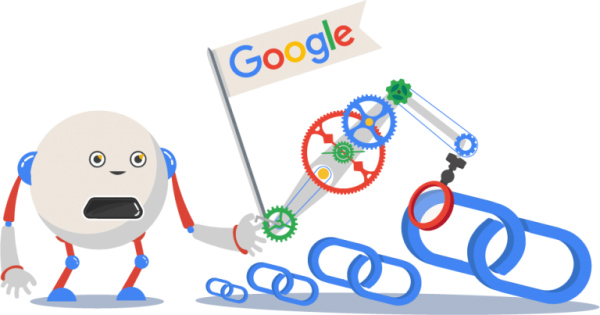
Important: Don’t try to improve your site’s ranking by buying links or using link boosting tools. Google has continuously updated to uncover these types of methods of manipulation that are harmful to users. You run the risk of being penalized for dropping a huge ranking in the rankings and destroying all your hard work, time and money to create.
#4. Google Update
Google regularly refreshes its search engine algorithms. These updates improve search results by gradually optimizing specifications for site quality and relevance. At the same time, they fight web spam.

Among Google’s well-known updates were “Google Panda” and “Google Penguin” in 2011. These two updates have ensured that sites with bad content and suspicious links are hard to find. get good ratings. Although updates are used regularly on fixed dates, Panda and Penguin have been converted into a continuous update. This is gradually improving Google’s algorithm and patching the holes that black hat SEOs are operating.
#5. How to use social media to distribute content
Social networks play an important role in web usage. They are used by billions of users around the world, and the number continues to grow. On Facebook alone, there were over 1.7 billion active users in the second quarter of 2016.
Just like Facebook, there are some equally important social networks, like Twitter, Tumblr, Instagram, Snapchat and Pinterest. Social networks play an important role in the distribution of traffic and links to websites.

Search engines also take into account the traffic generated by links from social networks. It is assumed that these so-called “social signals” can affect the ranking of a website at least as far as search queries are concerned at the present time.
You should not only use social networks to acquire new leads, generate leads, and build brand awareness, but also keep in mind the benefits of SEO in the presence of your brand. brand on social networks.
For example, make sure your content is easily shareable. The easiest way to do this is to place social buttons on your website. It will automatically add the share button for you.
Note that when using social networks, you should also maintain these channels and regularly update new content.
#6. How to use email to deliver content
These days nearly every company uses email to manage customer relationships and find new customers. It’s no surprise that email marketing has really grown in recent years because traditional mailing and faxing are dead. Setting up an email marketing campaign, uploading an address list, and communicating with customers shouldn’t be too difficult. That said, customers can also receive emails from a multitude of different companies, so your message information and subject matter must be unique to get them to open your email and initiate conversion actions.
Social networking guidelines also apply to your email. Your email should include a clear call-to-action, you should maintain lists, generate leads, and convert them into customers, but you should also make it easy for email readers to share. Share content with friends and post on social media site. This will also expand the reach of your site’s content and give you more backlinks.
#7. Guest Posts
Guest articles are a good way to improve your branding and get high-quality backlinks for off-page SEO optimization. Therefore, you should look for good website channels that allow you to publish your content.
Once you have found a suitable partner, you can not only create backlinks but also become an expert in a certain field at that website.
#8. Blogging
Blogs have grown significantly over the past 10 years. Many companies have run their own blogs and use them to publish articles on their topic areas and company news. Content by other authors may also be posted. This produces high-quality and relevant content that provides a lot of added value for users, customers, and potential customers.

It allows you to increase traffic to your website while also allowing other users to voluntarily link to you.
If you also share your blog posts on social networks and in your newsletter, you can generate additional traffic.
Part 4: Keyword Research
#first. Identify long tail keywords (roughly translated “long tail”)
As discussed in this part of the ebook on “Long Tail Concepts & Theory”, focusing on long-tail keywords is key to successful search engine optimization. While these keywords have lower traffic than general short-tail terms, they are generally associated with better quality traffic. The good news is that choosing the right long-tail keywords for your website is a very simple process.

Relevance is key when choosing the right keywords. Note that the more details and relevant keywords, the better.
Let’s say you have a swimming pool installation company: Which keywords will attract more potential customers to your business?
“Swimming Pool” or “Installing a Fiberglass Pool”
Apparently, visitors searching for “Install a fiberglass swimming pool” are already in product/service research mode.
They’re trying to learn about installation or find someone who will install a pool- and that could be you! Optimizing for “pools” has some value, but there’s no doubt this keyword targets a much broader audience of people who may or may not have any interest in your services.
Another factor to keep in mind is optimizing on the right keywords for location-based searches.
Search engine users will often include their location in the search when looking for suppliers and contractors in their area. The search term “Installing a fiberglass pool” then became “Installing a fiberglass pool in Manchester.”
If you only run your business in one region, you might consider including location-based keywords on all of your websites, because traffic from other regions won’t make it. your help. If your business operates in different regions, you should set up a separate page for each region so your brand appears wherever people are searching.
#2. How to test your website analytics tool

Analytics tools like Google Analytics, Google Search Console, Ryte, and HubSpot allow you to examine many important details about your website and its usage. For example, the HubSpot tool can identify which organic keywords are driving traffic to your site. The same is true for Google Search Console, which is free. These keywords create a good core keyword base and give you a list of keywords that you can use to measure the performance of your future SEO efforts.
With Ryte, you can integrate data from Google Search Console and Google Analytics through the interface. Because Google Search Console only stores keywords for 30 days, you can use Ryte to access older data. You also find out the keywords that are being used to find your site in the SERPs and bounce and click-through rate (CTR) data. This way, you immediately know users are satisfied with their web search results, and you can refine your content or technology accordingly.
#3. Tools for keyword research
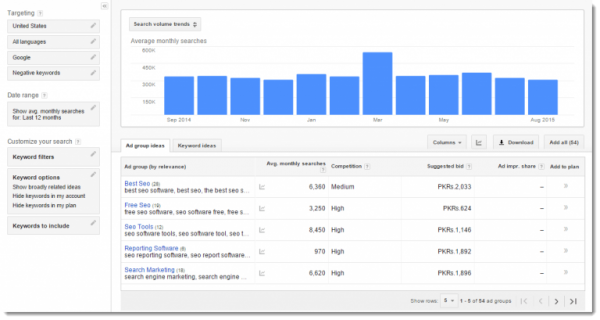
Google’s Keyword Planner is a free tool that can help you with keyword research. This tool is actually designed for the advertising program of Google AdWords and is intended to help marketers choose the right keywords for ad placement. But it can also help you with search engine optimization.
For example, you can use the Keyword Planner to find the right phrases for a keyword. Google tools can also show you search terms related to your website URL. For example, you can also enter your competitor’s URL and search for such related keywords.
Traffic trends and data can also be used to determine how often searches are run for each keyword.
Keywordtool.io also has its own “Keywords” tool, which can help you find the best keywords to optimize your website for. It also includes detailed data for each keyword. This tracking feature allows you to see which keywords are really generating traffic and leads, and you can use this information to continue optimizing over the long term.
If you just want to find search trends, you can use Google’s free “Google Trends” tool. You can run searches there to find global or regional search trends for terms of interest.
#4. How to search for keywords?
Besides studying your web analytics data and using keyword research tools, there is another very simple research method: Use the search engine itself to do keyword research.

Search engines can provide answers to several key questions:
How many competitors are there? See how many search results there are. If there are hundreds of thousands or millions of results, you should ask yourself if it is worth the time and trouble to operate in that area.
How do your competitors rank? Choose a keyword for which you want to optimize your website. Check out the top 20 search results: Is your competition somewhere in there? What is your ranking for this keyword? This information will help you find a niche for you and your keywords where your competitors aren’t active. You can also find keywords for which it is worth competing.
Did Google make any other suggestions? When you enter a keyword in Google, your search form is populated with search results while you are still typing.
This feature is called “Google Suggest”.




